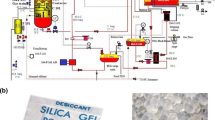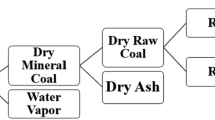Abstract
Considering that a significant part of used refrigerants have to be destroyed in an environmentally friendly manner together with the high global warming potential (GWP) of HFCs (hydrofluorocarbons), the development of a proper incineration method of HFCs becomes one of the viable methods in the refrigeration and air-conditioning industry. To this end, in this study, the development of a comprehensive modeling of CHF3 (HFC-23 or R-23) incineration is made to assist in the proper design and determination of optimal operating condition of a practical HFCs incinerator, since the refrigerant of CHF3 is one of typical HFCs. For this, numerical investigation was performed by the development of a predictive model for the thermal destruction of the CHF3 using CH4–air flames in an incinerator designed for CDM (clean development mechanism) project. First of all, comparison between calculation and operation data was made to evaluate the program developed in this study. Numerical calculation of CHF3–CH4–air flame predicts successfully the operation data of a CDM incinerator such as temperature, CHF3 destruction rate more than 99.99 % and other species concentrations such as CO and NO at the exit of the incinerator. Further parametric study was performed also in terms of important variables such as excess air, amount of steam and incinerator size. In general, the results obtained appear physically acceptable and give a clear physical insight into the role of the important variables. Further work is strongly recommended for the development of a general turbulent reaction model for the thermal destruction of HFCs, especially for the condition of non-equilibrium turbulent reaction dominance.






Similar content being viewed by others
Explore related subjects
Discover the latest articles and news from researchers in related subjects, suggested using machine learning.References
http://www.epa.gov/ozone/title6/608/608fact.html, Complying With The Section 608 Refrigerant Recycling Rule, 2011
China Fluoro Technology Co. (2007) CDM monitoring Report, UNFCCC(United Nations Framework Convention on Climate Change) CDM reference number 1194
Womeldorf C, Grosshandler W, Mitchell M (1995) Selection of a Simulant of CF3Br for Use in Engine Nacelle Certification Tests. HALON OPTIONS TECHNICAL WORKING CONFERENCE 5
Linteris, GT (1996) Numerically predicted structure and burning velocity of premixed CO-Ar-O ~ 2-H ~ 2 Flames Inhibited by CF ~ 3H. Combustion and Flame. 107(1-2) [SCI,SCIE,SCOPUS]
Shebeko YuN, Azatyan VV, Bolodyan IA, Navzenya VYu, Kopylov SN, Shebeko DYu, Zamishevski ED (2000) The influence of fluorinated hydrocarbons on the combustion of gaseous mixtures in a closed vessel. Combust Flame 121:542–547
Takizawa KA, Takahashi K, Tokuhashi S, Kondo A, Sekiya (2005) Burning velocity measurement of fluorinated compounds by the spherical-vessel method. Combust Flame 141(3):298–307
Katta VR, Roquemore W (2005) Effect of Nitromethane on Soot Formation in Heptane Jet Diffusion Flame. Joint Meeting- US Sections of the Combustion Institute 4
Gmurchyk GW, Grosshandler WL, Lowe DL (1995) Proceedings of the 4th International Symposium on Fire Safety Science. Ottawa. Canada 925
Katta VR, Takahashi F, Linteris GT (2006) Fire-suppression characteristics of CF3H in a cup burner. Combust Flame 144(4):645–661
Azatyan VV, Shebeko YN, Shebeko AY (2007) Effect of self-inhibition at a flame propagation in rich gaseous mixtures of combustible-air-diluent. J Loss Prevent Process Industri 20(4–6):486–493
Azatyan VV, Bolodyan IA, Navtsenya VY (2010) The dependence of the rules governing gas-phase combustion on the competition between chain propagation and chain termination reactions. Russian J Physical Chem C/C Zhurn 84(3):383–390
Kee RJ, Rupley FM, Miller JA (1989) Chemkin-II: a Fortran chemical kinetics package for the analysis of gas-phase chemical kinetics. Sandia National Laboratories Report. SAND89-8009B
Bilger RW (1976) Turbulent jet diffusion flames. Energy Comb Sci 1:87
Spalding DB (1971) Mixing and chemical reaction in steady confined turbulent flames. Thirteenth symposium (international) on combustion. The Combustion Institute, pp 649–657
Magnussen BF, Hjertager H (1976) On mathematical modeling of turbulent combustion with special emphasis on soot formation and combustion. 16th symposium (international) on combustion. The Combustion Institute. Pittsburgh. PA 714
Jang DS, Acharya S (1988) Two dimensional modeling of waste combustion in a kiln. AIChE Spring Meeting, New Orleans
Shin MS, Kim YJ, Jang DS, Lee YG, Lee KW (2014) Numerical study on the Co-firing flame characteristics of CH4 and refrigerant R-100(CCl4). J Korea Soc Waste Manage 31(8):868–869
Jang DS, Acharya S (1990) A numerical simulation of ccl4 destruction in a two-dimensional kiln. Energy R&D J Korea Res Instit Energy 12(3):94–111
Ohm T, Jang DS, Chae J (1993) A study for the advanced design of rotary kiln incinerator III: 3-dimensional CCl4/CH4 gas-phase turbulent reaction model. Korean Energy Eng 2(1):54–67
Chun YN, Lee KJ, Song HO (2002) A numerical simulation of hazardous waste destruction in a three-dimensional dump incinerator. Korean J Chem Eng 19(1):20–27
Chun YN, Jung OJ, Kim SW, Song HO (2003) Numerical and experimental studies of CCl4 destruction in a dump incinerator. Environ Technol 24(2):131–142
Jones A, Bliss H, Walker C (1996) Rates of hydrogen chloride oxidation. AIChE J 12:260
Launder BW, Spalding DB (1972) Mathematical models of turbulence. Academic Press, New York
Chandrasekhar S (1960) Radioactive transfer dover. New York
Kim HS, Shin MS, Jang DS, Ohm TI (2004) Numerical study of SNCR application to a full-scale stoker incinerator at Daejon 4th industrial complex. Appl Therm Eng 24(14–15):2117–2129
Acknowledgments
This project was supported by the “R&D Center for reduction of Non-CO2 Greenhouse gases (2013001690006)” funded by the Korea Ministry of Environment (MOE) as the “Global Top Environment R&D Program”.
Author information
Authors and Affiliations
Corresponding author
Rights and permissions
About this article
Cite this article
Shin, M., Jang, D., Lee, Y. et al. Comprehensive modeling of HFC-23 incineration in a CDM incinerator. J Mater Cycles Waste Manag 19, 754–762 (2017). https://doi.org/10.1007/s10163-016-0476-1
Received:
Accepted:
Published:
Issue Date:
DOI: https://doi.org/10.1007/s10163-016-0476-1




